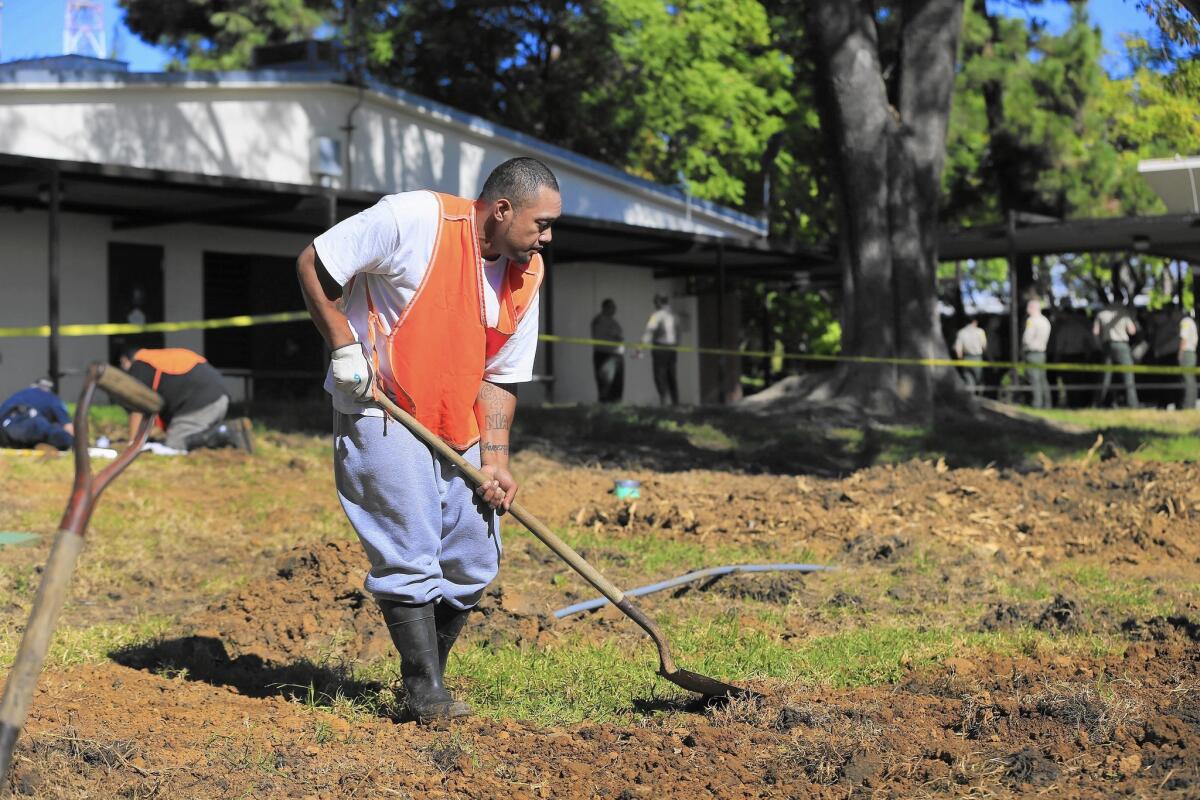Unintended consequences of Prop. 47 pose challenge for criminal justice system

Semisi Sina, shown digging up a lawn as part of his work release sentence, has been arrested 16 times and said he didn’t start stealing bicycles until Proposition 47 raised the threshold for a felony theft to $950.
Semisi Sina has kept sheriff’s deputies busy in the last year.
The 30-year-old has stolen bicycles from his Hacienda Heights neighborhood. He has skipped out on drug treatment and kept up his meth habit.
He has racked up 16 arrests, earning himself a place near the top of the Los Angeles County Sheriff’s Department’s list of repeat offenders picked up for theft or drug use. And he says a new law has made it easier for him to commit crimes.
NEWSLETTER: Get essential California headlines delivered daily >>
“Now, you can get away with it because of Proposition 47,” Sina said recently in an interview at his parents’ home.
One year after voters approved the landmark ballot measure, Proposition 47 has dramatically altered California’s criminal justice landscape.
The proposition, which downgraded drug possession and some theft crimes to misdemeanors, made good on its pledge to reduce prison and jail populations by thousands of inmates. Tens of thousands more people with older felony convictions have been able to wipe their records clean, giving them the chance to qualify for new jobs and other benefits.
But law enforcement officials and others have blamed Proposition 47 for allowing repeat offenders like Sina to continue breaking the law with little consequence.
Crime has risen in the state’s largest cities, setting off debate over whether the proposition is responsible. In some areas, street cops are making fewer narcotics arrests.
And without the threat of a felony conviction and a lengthy stint behind bars, fewer drug offenders are enrolling in court-ordered treatment in Los Angeles and other counties.
“Proposition 47 was good and bad,” said Thomas Loversky, a Manhattan Beach-based criminal defense attorney who has clients in drug court. “The good part is we have people who shouldn’t be spending time in jail not spending time in jail. The bad part of Proposition 47 was there was no hammer to force people who needed treatment to get it.”
Lenore Anderson, executive director of Californians for Safety and Justice and an author of the measure, said courts and law enforcement agencies need to adjust to the new landscape by innovating — for example, by funneling offenders into treatment before they even see a judge.
Misdemeanors, which can carry one-year sentences, can be used in the same carrot-and-stick way as felonies, she said.
“Proposition 47 is working,” Anderson said. “It’s reducing the state prison population, it’s giving people second chances and it’s saving state money that has never been saved before.”
Los Angeles County Sheriff Jim McDonnell is among the law enforcement officials who believe that Proposition 47 has led to more crime while forcing fewer addicts into treatment.
“We’ve removed the disincentive, but we haven’t created a meaningful incentive,” McDonnell said in an interview last week. “We’re putting the people we’re trying to help in a position where we can’t help them.”
If the purpose of [Proposition] 47 was largely to rehabilitate drug offenders, that’s not what’s happening.
— Mike Feuer, Los Angeles City attorney
McDonnell said he agrees with the goals of the proposition: reducing incarceration while providing treatment for drug addicts.
A drop in the state prison population because of Proposition 47 is expected to save about $100 million annually, according to a state estimate. Under the terms of the law, that money will go toward treatment and education programs beginning in late 2016.
But McDonnell and others questioned whether that windfall will be enough to cover all those who need help.
At some point, McDonnell said, he might advocate for the proposition to be revised — for example, by increasing the penalties after repeat misdemeanor convictions.
Sheriff’s deputies are sometimes passing up narcotics arrests altogether, since it can take hours to book a suspect they believe is unlikely to incur much of a penalty. Narcotics arrests by sheriff’s deputies are down 30% from a year ago, despite McDonnell’s orders to his deputies to keep making arrests.
At the same time, areas of Los Angeles County patrolled by the Sheriff’s Department have seen property crime climb nearly 8% from last year. Auto thefts alone are up over 20%. Sheriff’s officials say there is a link between drug and property crimes as some addicts steal to support their habits.
Statewide, property crime has increased in nine of California’s 10 largest cities this year, a Times review found. Violent crime has increased in all 10.
Proponents of Proposition 47 say it is too soon to connect the ballot measure to rising crime and question why police aren’t making misdemeanor arrests.
Criminologists also caution against attributing fluctuations in crime to a single cause.
Keramet Reiter, a criminology professor at UC Irvine, said the ballot measure has been used by critics as a “convenient scapegoat” for the rise in crime. The reality, she said, is more complicated in a state that is undergoing broad changes to its criminal justice system, including a massive shift of inmates from state prisons to local jails.
The Los Angeles Police Department has reported a double-digit increase in property crime so far this year, but Chief Charlie Beck said it is premature to fault Proposition 47.
“The studies are not done and the results aren’t in,” Beck said.
County jail populations were down by about 12% statewide in the first quarter of 2015, the most recent figures available, according to the Board of State and Community Corrections. Counties are not required to put their cost savings into programs.
In Los Angeles County, which has the largest jail system in the country, Proposition 47 has opened up beds for some offenders to serve more of their sentences rather than being released early. County-sentenced inmates are serving about 70% of their sentences versus 20% before the measure passed.
As the criminal justice system adjusts to the ballot measure, repeat offenders are sometimes being sentenced to jail time or drug treatment on misdemeanors, court records show. But getting them to follow through with the treatment can be a challenge.
Judges got tougher on Sina, the Hacienda Heights offender, as his rap sheet grew. After a May 7 arrest, he spent two months behind bars.
Shortly after he was released on July 9, he resumed his criminal activities. On July 31, he pleaded guilty to stealing a bicycle from a shopping mall employee while she was at work. A judge sentenced him to nine months behind bars.
Last month, he left jail to finish his sentence in a work program.
Sina said he rejoiced when he first heard about Proposition 47. He said he didn’t start stealing bicycles until the proposition raised the threshold for a felony theft to $950.
“Proposition 47, it’s cool,” Sina said. “Like for me, I can go do a [commercial] burglary and know that if it’s not over $900, they’ll just give me a ticket and let me go.”
He was sentenced to rehab five times this year but did not show up for a single session.
“I know it’s up to me to change. I wasn’t ready. I probably still am not. I’m not going to lie — I’m still not ready to quit,” he said Tuesday on a break from shoveling dirt at a sheriff’s training facility in Whittier.
In Hacienda Heights, another repeat offender, Carlos Jimenez, was arrested for meth possession twice in one week. Jimenez praised the proposition, saying jail doesn’t help and exposes inmates to other criminals.
He is enrolled in a drug treatment program after struggling with meth addiction for 20 years.
“It all just becomes about you in the end,” said Jimenez, 36. “If you want to stop, you stop. If you don’t, you don’t.”
Across L.A. County, enrollment in specialized drug court programs has plummeted by 50%. Through Oct. 15, about 300 people were admitted into drug court, compared with nearly 600 during the same period last year, according to the county.
Of the Proposition 47 cases handled by the city attorney’s office, only 73 of nearly 2,200 drug offenders sentenced in the first eight months of the year entered some sort of court-ordered treatment, according to City Atty. Mike Feuer.
“If the purpose of [Proposition] 47 was largely to rehabilitate drug offenders, that’s not what’s happening,” Feuer said.
Feuer’s office is working with police and rehab providers to create a diversion program that would give offenders the option of drug treatment in lieu of prosecution.
There are signs that drug courts are also beginning to adapt.
Los Angeles County Superior Court Judge Terry Smerling said his drug court in Pasadena had long used the threat of a significant time behind bars to encourage offenders to enroll. After the measure passed, many drug offenders declined to enroll, preferring a short stint in jail to the longer treatment program.
Smerling said he began including more serious criminals facing lengthier sentences if the root cause of their crimes was drug addiction. His program now includes a larger number of people charged with domestic violence, car theft and other types of felonies.
For Patrick Khachatoorian, the new criteria were a blessing.
After leading CHP officers on a high-speed pursuit from Alhambra to Pacoima, he was charged with felony evading on Nov. 4, 2014 — the day voters passed Proposition 47.
At a drug court graduation ceremony last week, Khachatoorian, 30, said he’d known for years that he needed treatment but that his heroin addiction had clouded his reasoning.
He looked into the audience at his sister and his father.
“I finally put a smile on their face after so many years,” Khachatoorian said, his voice quavering. “I’m not trying to take that smile off.”
ALSO:
Classes resume at UC Merced campus after stabbing rampage
Former Raiders player Anthony Wayne Smith convicted in 3 murders
Defense offers glimpse of drama to come in San Francisco’s ‘Shrimp Boy’ trial
More to Read
Start your day right
Sign up for Essential California for news, features and recommendations from the L.A. Times and beyond in your inbox six days a week.
You may occasionally receive promotional content from the Los Angeles Times.









